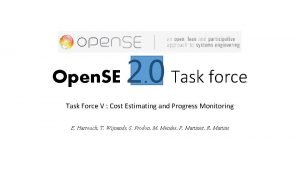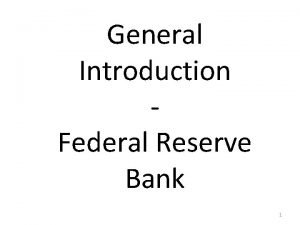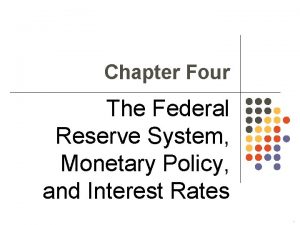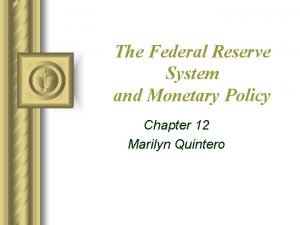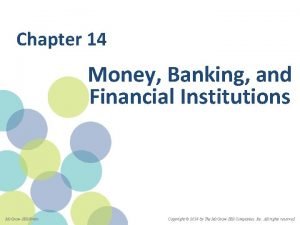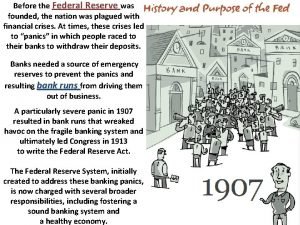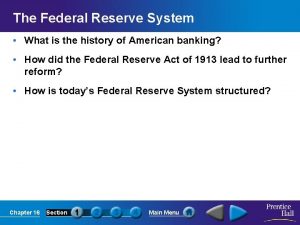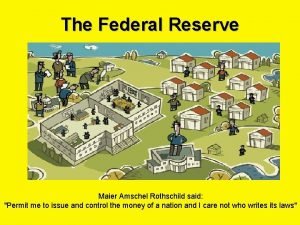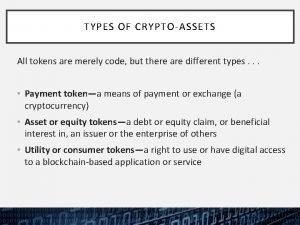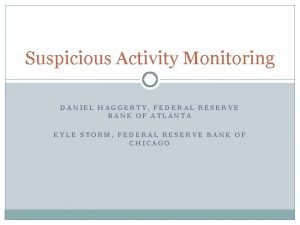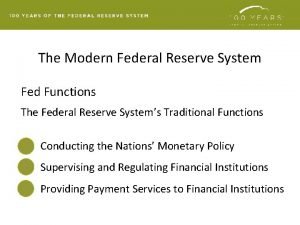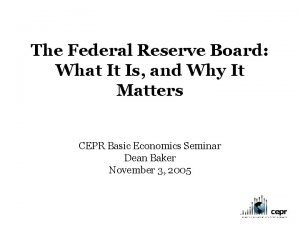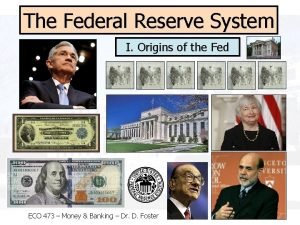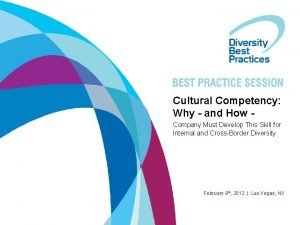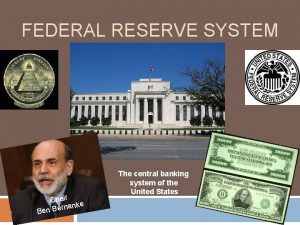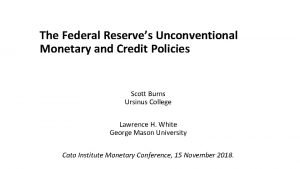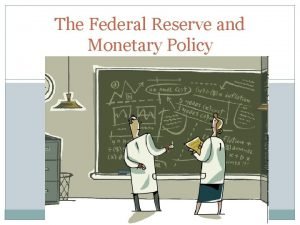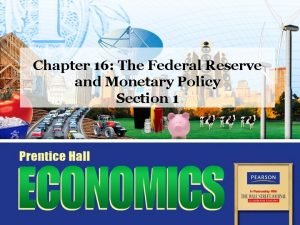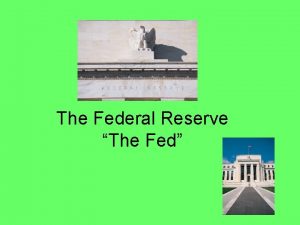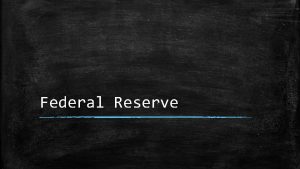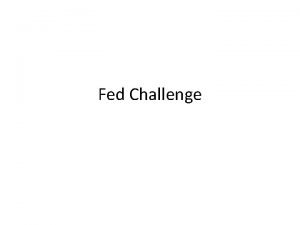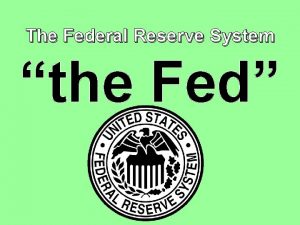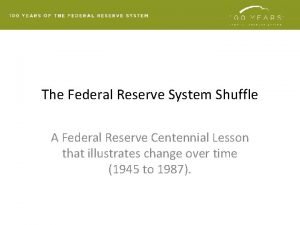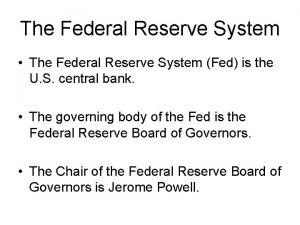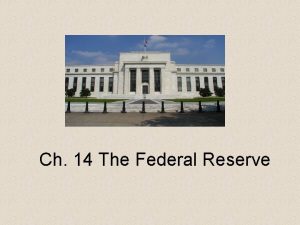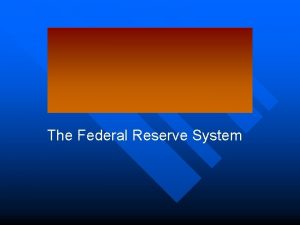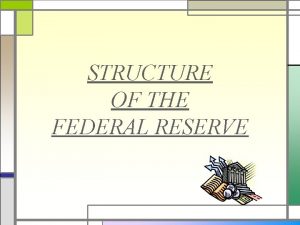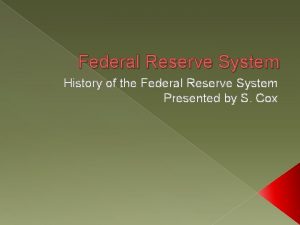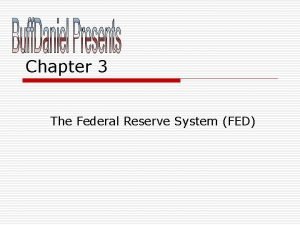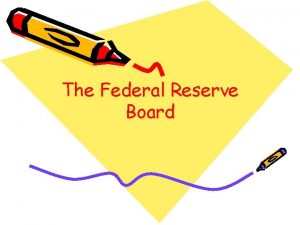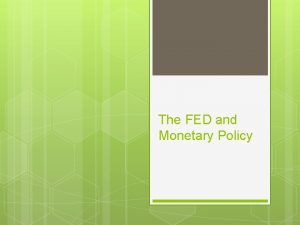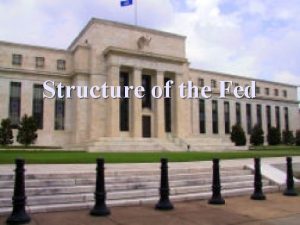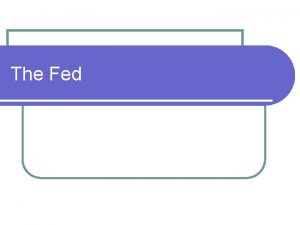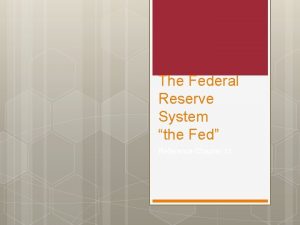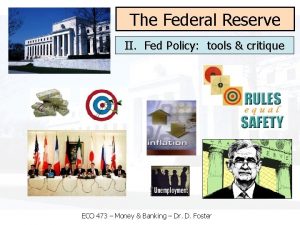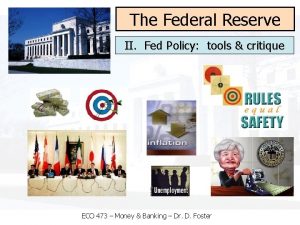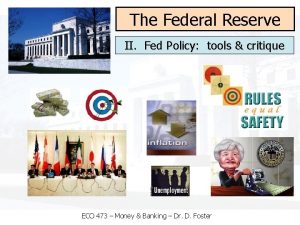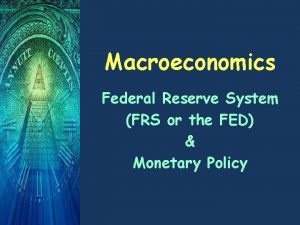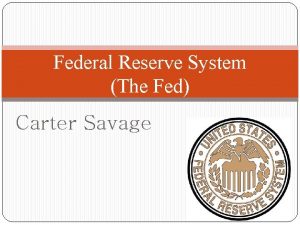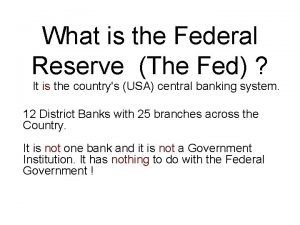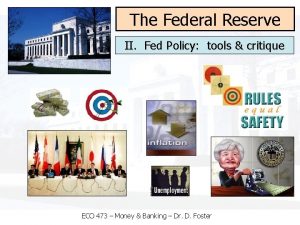Creating The Fed The Federal Reserve Act of


























- Slides: 26

Creating “The Fed” • The Federal Reserve Act of 1913 – The Federal Reserve System, often referred to as “the Fed, ” is a group of 12 regional independent banks – Initially the Federal Reserve System did not work well because the actions of one regional bank would counteract the actions of another…

12 Fed Districts

Structure of the Fed • The Board of Governors – The Federal Reserve System is overseen by the seven-member Board of Governors of the Federal Reserve. Actions taken by the Federal Reserve are called monetary policy. – The Chairman Currently is Ben Bernanke • Federal Reserve Districts – The Federal Reserve System consists of 12 Federal Reserve Districts, with one Federal Reserve Bank per district. The Federal Reserve Banks monitor and report on economic activity in their districts

Structure of the Fed (Cont. ) • Member Banks – All nationally chartered banks are required to join the Fed. Member banks contribute funds to join the system, and receive stock in and dividends from the system in return. This ownership of the system by banks, not government, gives the Fed a high degree of political independence (important!) • The Federal Open Market Committee (FOMC) – The FOMC, which consists of The Board of Governors and 5 of the 12 district bank presidents, makes key decisions about interest rates and the growth of the United States money supply

4, 000 member banks and 25, 000 other depository institutions Board of Governors Federal Open Market Committee 12 District Reserve Banks Structure of the Federal Reserve System

What does the Fed do? – Ultimately, the Fed establishes monetary policy: the actions the Federal Reserve takes to influence the level of real GDP and the rate of inflation in the economy

The Fed serves the Government • Federal Government’s Banker – The Fed maintains a checking account for the Treasury Department and processes payments such as social security checks and IRS refunds. • Government Securities Auctions – The Fed serves as a financial agent for the Treasury Department and other government agencies. The Fed sells, transfers, and redeems government securities. Also, the Fed handles funds raised from selling T-bills, T-notes, and Treasury bonds. • Issuing Currency – The district Federal Reserve Banks are responsible for issuing paper currency, while the Department of the Treasury issues coins.

The Fed Serves Banks • Check Clearing – Check clearing is the process by which banks record whose account gives up money, and whose account receives money when a customer writes a check. • Supervising Lending Practices – To ensure stability in the banking system, the Fed monitors bank reserves throughout the system. The Fed also protects consumers by enforcing truth-inlending laws. • Lender of Last Resort – In case of economic emergency, commercial banks can borrow funds from the Federal Reserve… • The interest rate at which banks can borrow money from the Fed is called the discount rate. • The interest rate that banks charge each other is called the federal funds rate (this is the key interest rate that drives many other interest rates)

I’m just a check… • After you write a check, the recipient presents it at his or her bank • The check is then sent to a Federal Reserve Bank • The reserve bank collects the necessary funds from your bank and transfers them to the recipient’s bank • Your processed check is returned to you by your bank – Almost all of this is done electronically now – even the check writing…

The Fed Regulates • Reserves – Each financial institution that holds deposits for its customers must report daily to the Fed about its reserves and activities. – The Fed uses these reserves to control how much money is in circulation at any one time.

The Fed Regulates • Bank Examinations – The Federal Reserve examines banks periodically to ensure that each institution is obeying laws and regulations. – Examiners may also force banks to sell risky investments if their net worth, or total assets minus total liabilities, falls too low.

Demand For Money • Factors That Affect Demand for Money – 1. Cash needed on hand • (Cash makes transactions easier. ) – 2. Interest rates • (Higher interest rates lead to a decrease in demand for cash. ) – 3. Price levels in the economy • (As prices rise, so does the demand for cash. ) – 4. General level of income • (As income rises, so does the demand for cash. )

Monetary Policy Tools • Money creation is the process by which money enters into circulation… • How Banks Create Money – Assume that you have deposited $1, 000 dollars in your checking account. The bank doesn’t keep all of your money, but rather lends out some of it to businesses and other people. – The portion of your original $1, 000 that the bank needs to keep on hand, or not loan out, is called the required reserve ratio (RRR). The RRR is set by the Fed. – As the bank lends a portion of your money to businesses and consumers, they too may deposit some of it. Banks then continue to lend out portions of that money, although you still have $1, 000 in your checking account. Hence, more money enters circulation…

Money Creation • To determine how much money is actually created by a deposit, we use the money multiplier formula. The money multiplier formula is calculated as 1/RRR… Money Creation You deposit $1, 000 into your checking account. Your $1, 000 deposit minus $100 in reserves is loaned to Elaine, who gives it to Joshua. $100 held in reserve $900 available for loans Joshua’s $900 deposit minus $90 in reserves is loaned to another customer. At this point, the money supply has increased by $2, 710. $90 held in reserve $810 available for loans

Calculating the Multiplier • If the RRR is 5% how much money will be available on your $1, 000 deposit?

Tools for the Fed • The Fed has three main tools to adjust the money supply: – Reserve Requirement – Discount Rate – Open Market Opportunities (buying and selling bonds)

Reserve Requirements • Reducing Reserve • Increasing Reserve Requirements – A reduction of the – Even a slight increase RRR would free up in the RRR would reserves for banks, require banks to hold allowing them to more money in make more loans. reserve, shrinking the money supply. – A RRR reduction would also increase – This method is not the money multiplier. used often because it Both of these effects would cause too would lead to a much disruption in substantial increase the banking system. in the money supply.

Discount Rate • Reducing the Discount Rate – If the Fed wants to encourage banks to loan out more of their money, it may reduce the discount rate, making it easier or cheaper for banks to borrow money if their reserves fall too low. – Reducing the discount rate causes banks to lend out more money, which leads to an increase in the money supply. • Increasing the Discount Rate – If the Fed wants to discourage banks from loaning out more of their money, it may make it more expensive to borrow money if their reserves fall too low. – Increasing the discount rate causes banks to lend out less money, which leads to a decrease in the money supply.

Open Market (the most important) • Bond Sales – When the Fed sells bonds, it takes money out of the money supply. – When bond dealers buy bonds they write – The bonds are purchased a check and give it to with money drawn from the Fed. The Fed funds. When this processes the check, money is deposited in and the money is the bank of the bond taken out of seller, the money supply circulation. increases. • Bond Purchases – In order to increase the money supply, the Federal Reserve Bank of New York buys government securities on the open market.

Controlling Money Supply Increase Money Supply Decrease Money Supply Reserve Requirements Decrease RRR Increase RRR Discount Rate Decrease Rate Increase Rate Buy Bonds Sell Bonds Open Market

Interest Rates and Spending • If the Fed adopts an “easy money policy, ” it will increase the money supply. This will lower interest rates and increase spending. This causes the economy to expand. • If the Fed adopts a “tight money policy, ” it will decrease the money supply. This will push interest rates up and will decrease spending.

Monetary Policy • Monetarism is the belief that the money supply is the most important factor in macroeconomic performance. • The Money Supply and Interest Rates – The market for money is like any other, and therefore the price for money — the interest rate – is high when the money supply is low and is low when the money supply is large…

Policy Lags - Timing • Inside Lags – An inside lag is a delay in implementing monetary policy. – Inside lags are caused by the time it actually takes to identify a shift in the business cycle. • Outside Lags – Outside lags are the time it takes for monetary policy to take affect once enacted.

Predicting the Cycle • The Federal Reserve must not only react to current trends, but also must anticipate changes in the economy. • Monetary Policy and Inflation – Expansionary policies enacted at the wrong time can push inflation even higher. – If the current phase of the business cycle is anticipated to be short, policymakers may choose to let the cycle fix itself. If a recession is expected to last for years, most economists will favor a more active monetary policy.

Predicting the Economy • How Quickly Does the Economy Self-Correct? – Economists disagree about how quickly an economy can self-correct. Estimates range from two to six years… – Since the economy may take quite a long time to recover on its own, there is time for policymakers to guide the economy back to stable levels of output and prices.

Combining Monetary and Fiscal Policy Expansionary Tools use when the economy is in a recession Contractionary Tools Use when the economy is expanding too fast Monetary Policy 1. Increase G 2. Decrease T 1. Buy Bonds 2. Reduce RRR 3. Decrease Discount Rate 1. Decrease G 2. Increase T 1. Sell Bonds 2. Increase RRR 3. Increase Discount Rate
 Source of capital reserve
Source of capital reserve Contingency reserve vs management reserve
Contingency reserve vs management reserve Difference between capital reserve and reserve capital
Difference between capital reserve and reserve capital Federal reserve bank
Federal reserve bank Federal reserve
Federal reserve The three parts of the federal reserve system
The three parts of the federal reserve system Banking panics
Banking panics Federal reserve founded
Federal reserve founded Ferderal reserve system
Ferderal reserve system Rothschild federal reserve 1913
Rothschild federal reserve 1913 Federal reserve jurisdiction
Federal reserve jurisdiction The federal reserve and you video question answers
The federal reserve and you video question answers Suspicious activity monitoring
Suspicious activity monitoring What is the primary function of the federal reserve system
What is the primary function of the federal reserve system Federal reserve dual mandate
Federal reserve dual mandate The federal reserve system worksheet answers
The federal reserve system worksheet answers Federal reserve bank
Federal reserve bank Federal reserve system
Federal reserve system Who created the federal reserve
Who created the federal reserve Carol evans federal reserve
Carol evans federal reserve Jekyll island meeting 1913
Jekyll island meeting 1913 Federal reserve system
Federal reserve system Federal reserve pyramid
Federal reserve pyramid Federal reserve omaha
Federal reserve omaha Federal reserve
Federal reserve Structure of the federal reserve
Structure of the federal reserve The federal reserve system is overseen by the
The federal reserve system is overseen by the

